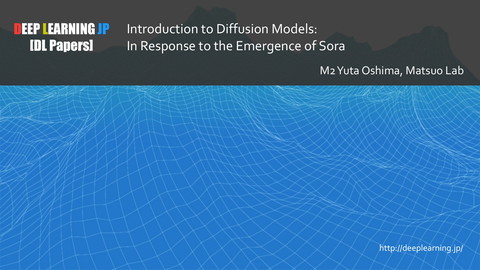【DL輪読会】Data-Efficient Reinforcement Learning with Self-Predictive Representations
650 Views
April 12, 21
スライド概要
2021/04/09
Deep Learning JP:
http://deeplearning.jp/seminar-2/
DL輪読会資料
関連スライド
各ページのテキスト
DEEP LEARNING JP [DL Papers] Data-Efficient Reinforcement Learning with Self-Predictive Representations Xin Zhang, Matsuo Lab http://deeplearning.jp /
目次 1. 書誌情報 2. Introduction 3. Self-Predictive Representation 4. Related Works 5. Experiment Evaluation 6. Discussion 2
書誌情報 ● タイトル: ○ Data-Efficient Reinforcement Learning with Self-Predictive Representations ● 著者 ○ Max Schwarzer, Ankesh Anand, Rishab Goel, R Devon Hjelm, Aaron Courville, Philip Bachman ● 所属:Mila, Université de Montréal, Microsoft Research ● 投稿日:2020/7/12 (arXiv), ICRL2021 Spotlight (7776) ● 概要 ○ 強化学習のサンプル効率をあげるため、表現学習をSelf-supervisedで行った。 ○ k step後の状態を予測する、状態予測ダイナミックスモデルを学習する。 ○ ただし、状態の潜在空間上において、予測を行うことで、複雑度を下げる。 3
Introduction 強化学習におけるサンプル効率問題 - Atrai game, 10~50 years. OpenAI Five 45000 years of experience. - 実世界では許されないので、サンプル効率を上げないといけない! - CVとNLPでは、自己教師表現学習が有効で、業績残している。 - 強化学習における表現学習が有効。前から研究されていた。 - - 強化学習のための状態表現学習(松嶋さんDL輪読会) 未来の状態が予測できるような、状態の表現が学習できないか? - 自己教師で.. - データ拡張が使えて.. 4
Self-Predictive Representations(SPR) Kステップ後の表現を予測できるように学習した状態表現 1. Online encoder and target encoder 2. Transition Model 3. Projection Heads 4. Prediction Loss 5
Self-Predictive Representations(SPR) Target encoder, using EMA of online encoder. 1. Online encoder and target encoder 2. Transition Model 3. Projection Heads 4. Prediction Loss 6
Self-Predictive Representations(SPR) 1 ステップずつ、Kステップ分の状態表現を予測する。 1. Online encoder and target encoder 2. Transition Model 3. Projection Heads 4. Prediction Loss 7
Self-Predictive Representations(SPR) Projection で小さい次元に圧縮する。predictionでさらに予測。 1. Online encoder and target encoder 2. Transition Model 3. Projection Heads 4. Prediction Loss 8
Self-Predictive Representations(SPR) ステップごとのCosine Similarity Lossを取る。 1. Online encoder and target encoder 2. Transition Model 3. Projection Heads 4. Prediction Loss 9
Self-Predictive Representations. 10
Related Works ● Data-Efficient RL ○ SiMPle:pixel-level transition model. ○ Data-Efficient Rainbow(DER) and OTRainbow: ○ 再構築Lossで潜在空間モデルを学習 ○ DrQ, RAD:image augmentationすることで多くのモデルベースよりも精度が良い ○ Data augmentionはマルチタスク、転移学習における汎化性の向上に有効 SPRのアプローチの方が、data-augmentationをさらに有効に使える。 11
Related Works ● Representation Learning in RL: ○ CURL:image augmentation + contrastive loss. ■ Image augmentationの方が効いる?(by RAD) ○ CPC, ST-DIM, DRIML:temporal contrastive losses. ○ DeepMDP, trains a transition model with L2 loss. ■ online encoder to prediction target. prone to representational collapse. ■ add observation reconstruction objective. ○ PBL:directly predicts representations of future states. ■ Two target networks. Focus on multi-task generalization. 100 times data as SPR. SPRはself-supervised, trained in latent space, uses a normalized loss. Target encoder. Augmentations. 12
Experiments. Atari Human-Normalized scores:人間のスコアを1.0 にして評価する基準。 SPRは、データ拡張しなくてもSOTA。 (*はデータ拡張。100k steps or 400k frames per game.) 13
Experiments SimPLeも良さそうだが、結果の分布で見るとわかりやすい。SPRはSOTA。 14
Experiments Dynamics modeling consistently improving performance. 15
Discussion 考察 - The target encoderは重要 - データ拡張がある時は、T=0. 並行して2つのencoderを学習する。 - 拡張がない時は、T=0.99. でほぼ固定 - Dynamics modelingは重要, K = 5. - 流行っているContrastive lossesよりは良い。 今後の方向性 - CVとNLPを見ると、RLにも大規模なデータセットで事前学習し、fine tuningする流れもやってくるのでは? - SPRで学習したモデルで、モデルベースの学習をやる。 16
感想 - サンプル効率問題に向けて、自己教師あり学習でモデルを学習するアプローチ は面白いと思って、読んだ。 - 思ったより、たくさんの研究があって、新規性をどう出すのか? - Self-Supervised * Model-based あたりが可能性高いと思っている。 17
参考文献 - https://zhuanlan.zhihu.com/p/164842371 - https://arxiv.org/pdf/2006.07733.pdf 18







